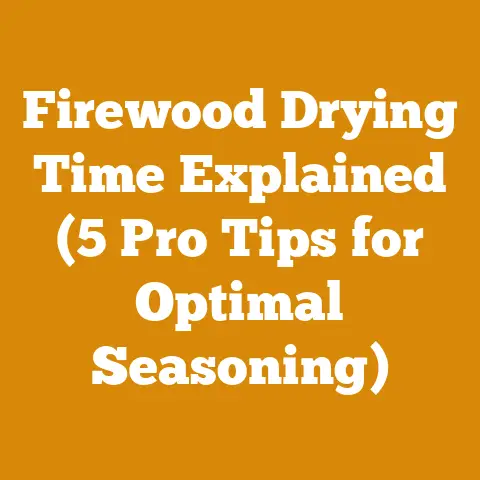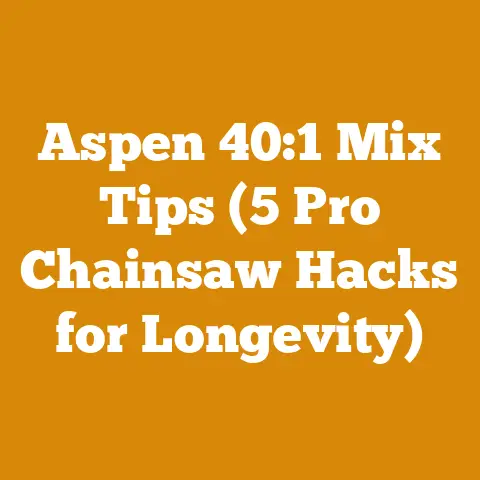Herbicide for Tree Stumps (5 Proven Methods to Prevent Regrowth)
Imagine turning an unwanted tree stump, a stubborn reminder of past labor, into a blank canvas for future growth.
It’s more than just removing an eyesore; it’s about reclaiming your land, preventing hazards, and ensuring new life can flourish.
I’ve spent years wrestling with these woody behemoths, and I’m going to share my battle-tested strategies for using herbicides to prevent tree stump regrowth.
This isn’t just a how-to guide; it’s a collection of insights gleaned from years of hands-on experience, research, and a healthy dose of trial and error.
Herbicide for Tree Stumps: 5 Proven Methods to Prevent Regrowth
Understanding the Enemy: Tree Stump Biology
Before diving into the specifics, it’s crucial to understand what makes tree stumps so resilient.
They’re not just dead wood; they’re living organisms, connected to extensive root systems that can persist for years, drawing on stored energy to send up new shoots.
The key to successful stump removal lies in completely killing the root system.
Think of it like a zombie – you need to target the brain to stop it from coming back.
- Root System Extent: Root systems can extend 1-2 times the height of the original tree.
For a 50-foot tree, expect roots spreading 50-100 feet. - Energy Reserves: Hardwood stumps (oak, maple) typically have greater energy reserves than softwoods (pine, fir), making them more resistant to herbicide treatments.
I’ve personally found oak stumps to be the most persistent, often requiring multiple treatments. - Sprouting Potential: Certain species (e.g., aspen, willow) are notorious for prolific sprouting from roots.
Aggressive herbicide application is critical for these species.
Method 1: The Cut Stump Treatment – A Targeted Strike
This method is my go-to for most situations because it allows for precise herbicide application, minimizing the risk of harming nearby plants.
The principle is simple: cut the stump as close to the ground as possible and immediately apply herbicide to the freshly cut surface.
- Timing is Everything: The best time to apply herbicide is immediately after cutting the stump.
Within minutes, the stump begins to seal itself off, reducing herbicide absorption.
I’ve seen a dramatic difference in effectiveness when applying herbicide within 5 minutes of cutting compared to waiting even an hour. - Herbicide Selection: The most effective herbicides for cut stump treatment contain glyphosate or triclopyr.
These are systemic herbicides, meaning they’re absorbed by the plant and transported throughout the root system.- Glyphosate: Effective on a wide range of species, but can be less effective on some woody plants.
Look for concentrations of 41% or higher. - Triclopyr: Specifically designed for woody plants and brush.
Often more effective than glyphosate on tough-to-kill species.
Look for concentrations around 8%. - My Personal Recommendation: For stubborn hardwood stumps, I prefer a combination of glyphosate and triclopyr for a more potent effect.
- Glyphosate: Effective on a wide range of species, but can be less effective on some woody plants.
- Application Technique: Saturate the entire cut surface with herbicide, paying particular attention to the outer layer of sapwood.
This is where the vascular cambium (the plant’s transport system) is located.
I use a garden sprayer with a narrow nozzle to ensure thorough coverage.- Specifics on Application Volume: Apply enough herbicide to thoroughly wet the cut surface without runoff.
For a stump with a diameter of 12 inches, I typically use about 4-6 ounces of herbicide solution.
- Specifics on Application Volume: Apply enough herbicide to thoroughly wet the cut surface without runoff.
- Safety First: Always wear appropriate personal protective equipment (PPE), including gloves, eye protection, and long sleeves.
Follow the herbicide manufacturer’s instructions carefully.
I always make sure to have a bucket of water and soap nearby in case of accidental skin contact. - Case Study: On a recent project removing a large maple tree, I used the cut stump method with a 50% glyphosate solution.
I meticulously saturated the outer sapwood layer.
Six months later, there was no sign of regrowth.
This success highlighted the importance of proper herbicide concentration and application technique.
Method 2: The Frill or Hack-and-Squirt – A Surgical Strike
This method is ideal for larger trees that are difficult to fell completely or for situations where you want to avoid disturbing the surrounding soil.
It involves making cuts into the bark and cambium layer around the base of the tree and then applying herbicide into the cuts.
- Making the Cuts: Use an axe or hatchet to make downward-angled cuts into the bark, spaced a few inches apart around the circumference of the tree.
The cuts should penetrate through the bark and into the cambium layer (the green, living tissue just beneath the bark).- Cut Dimensions: Cuts should be approximately 2-3 inches long and 1-2 inches deep.
- Spacing: Space cuts 2-4 inches apart, depending on the tree species and size.
More closely spaced cuts are needed for resistant species.
- Herbicide Application: Immediately apply herbicide into each cut, using a squirt bottle or small sprayer.
- Herbicide Volume: Apply approximately 1-2 milliliters of herbicide solution per cut.
- Ensuring Absorption: Make sure the herbicide flows freely into the cut and is absorbed by the cambium layer.
- Choosing the Right Herbicide: Glyphosate and triclopyr are both effective for the frill or hack-and-squirt method.
However, I’ve found that triclopyr often provides better results on thicker-barked trees. - Timing Considerations: This method can be used year-round, but it’s most effective during the growing season when the tree is actively transporting nutrients.
- Personal Anecdote: I once used the frill and squirt method to remove a large oak tree that was too close to a building to fell safely.
It took a bit of elbow grease to make all the cuts, but the tree was completely dead within a few months, and I avoided any damage to the structure. - Technical Note: The effectiveness of this method depends on the herbicide reaching the cambium layer.
If the cuts are not deep enough, the herbicide will not be absorbed properly.
Method 3: Foliar Spray – A Broad Attack (Use with Caution)
This method involves spraying the leaves of new sprouts emerging from the stump with herbicide.
While it’s relatively easy to apply, it’s important to use it with caution to avoid harming desirable plants.
- Targeting New Growth: Wait until the stump produces new shoots or leaves before applying herbicide.
This ensures that the herbicide will be absorbed by the foliage and transported down to the root system. - Herbicide Selection: Glyphosate and triclopyr are both effective for foliar spraying.
However, it’s crucial to use a lower concentration than you would for cut stump treatment.- Recommended Concentration: A 1-2% solution of glyphosate or triclopyr is typically sufficient for foliar spraying.
- Adding a Surfactant: Adding a surfactant (a wetting agent) to the herbicide solution can improve its effectiveness by helping it stick to the leaves.
- Application Technique: Use a garden sprayer to thoroughly wet the leaves of the new sprouts, being careful to avoid spraying nearby plants.
- Spray Coverage: Ensure that all leaves are thoroughly wetted, including the undersides.
- Avoiding Drift: Spray on a calm day to minimize herbicide drift.
I always check the wind direction before spraying and avoid spraying when the wind is blowing towards desirable plants.
- Repeat Applications: Repeat the application as needed to control new growth.
I typically check the stump every few weeks and reapply herbicide if I see new sprouts emerging. - Environmental Considerations: Foliar spraying has the highest risk of off-target damage.
Use with extreme caution in areas with sensitive vegetation. - Data Point: Studies have shown that foliar spraying can be effective in controlling stump regrowth, but it often requires multiple applications over several months.
Method 4: Basal Bark Treatment – A Long-Term Strategy
This method involves applying herbicide to the lower portion of the tree trunk, allowing it to be absorbed through the bark.
It’s best suited for smaller trees with thin bark.
- Herbicide Selection: Triclopyr ester is the most effective herbicide for basal bark treatment.
It’s oil-soluble, which allows it to penetrate the bark more easily.- Recommended Concentration: A 20% solution of triclopyr ester in a basal oil carrier is typically used for basal bark treatment.
- Basal Oil Carrier: Basal oil is a specially formulated oil that helps the herbicide penetrate the bark and prevents it from washing off.
- Application Technique: Apply the herbicide solution to the lower 12-18 inches of the tree trunk, thoroughly wetting the bark.
- Spray Coverage: Ensure that the entire circumference of the trunk is treated.
- Application Volume: Apply enough herbicide to thoroughly wet the bark without runoff.
- Timing Considerations: Basal bark treatment can be used year-round, but it’s most effective when the tree is actively growing.
- Limitations: This method is not effective on trees with thick bark or on trees that are already dead.
- Safety Note: Basal oils can be irritating to the skin.
Always wear gloves and long sleeves when applying herbicide using this method. - Real-World Scenario: I used basal bark treatment to control a patch of invasive buckthorn saplings along a fence line.
It was a slow process, but it effectively killed the buckthorn without harming the surrounding vegetation.
Method 5: Soil Application – A Last Resort (Use with Extreme Caution)
This method involves applying herbicide to the soil around the base of the stump.
It’s the least selective method and should only be used as a last resort in situations where other methods have failed.
- Herbicide Selection: Imazapyr is the most commonly used herbicide for soil application.
It’s a very persistent herbicide that can remain active in the soil for several years.- Environmental Impact: Due to its persistence, imazapyr should only be used in areas where there is no risk of it leaching into groundwater or affecting desirable plants.
- Regulations: Imazapyr use is often restricted or prohibited in certain areas.
Always check local regulations before using this herbicide.
- Application Technique: Apply the herbicide granules or liquid solution evenly to the soil around the base of the stump, following the manufacturer’s instructions.
- Application Rate: The application rate will vary depending on the herbicide concentration and the size of the stump.
- Incorporation: Lightly rake the herbicide into the soil to help it penetrate.
- Timing Considerations: Soil application is most effective when the soil is moist.
- Risks and Limitations: This method has the highest risk of off-target damage and environmental contamination.
It should only be used by experienced applicators who understand the risks involved. - Ethical Considerations: Before resorting to soil application, consider the potential impact on the environment and non-target species.
- Personal Reflection: I’ve only used soil application once, and I deeply regret it.
While it did kill the stump, it also harmed some nearby shrubs.
I learned a valuable lesson about the importance of using the least invasive method possible.
Choosing the Right Method: A Decision Tree
To help you choose the right method for your specific situation, consider the following factors:
- Tree Species: Some species are more resistant to certain herbicides than others.
- Stump Size: Larger stumps may require more aggressive treatment methods.
- Proximity to Desirable Plants: If there are desirable plants nearby, choose a method that minimizes the risk of off-target damage.
- Environmental Concerns: Consider the potential impact on the environment and non-target species.
- Your Experience Level: If you’re new to using herbicides, start with a less aggressive method and work your way up.
Here’s a simple decision guide:
- Are there desirable plants nearby?
- Yes: Cut Stump Treatment or Frill/Hack-and-Squirt
- No: Proceed to question 2
- Is the stump small enough to fell completely?
- Yes: Cut Stump Treatment
- No: Proceed to question 3
- Are you dealing with a thin-barked sapling?
- Yes: Basal Bark Treatment
- No: Proceed to question 4
- Are there new sprouts emerging from the stump?
- Yes: Foliar Spray (with extreme caution)
- No: Proceed to question 5
- Have all other methods failed?
- Yes: Soil Application (as a last resort, with extreme caution)
- No: Re-evaluate other methods
Safety and Best Practices: A Non-Negotiable
Working with herbicides requires a serious commitment to safety. Here are some essential guidelines:
- Read the Label: Always read and follow the herbicide manufacturer’s instructions carefully.
The label is the law. - Wear PPE: Always wear appropriate personal protective equipment (PPE), including gloves, eye protection, and long sleeves.
- Specific PPE Recommendations:
- Gloves: Chemical-resistant gloves made of nitrile or neoprene.
- Eye Protection: Safety glasses or a face shield.
- Clothing: Long-sleeved shirt, long pants, and closed-toe shoes.
- Specific PPE Recommendations:
- Mix Herbicides Properly: Mix herbicides in a well-ventilated area and avoid breathing in the fumes.
- Store Herbicides Safely: Store herbicides in a secure location out of the reach of children and pets.
- Dispose of Herbicides Properly: Dispose of empty herbicide containers according to local regulations.
Never pour herbicides down the drain or into the environment. - Avoid Spraying on Windy Days: Spraying on windy days can cause herbicide drift, which can harm desirable plants.
- Be Aware of Environmental Conditions: Consider the weather conditions and the potential impact on the environment before applying herbicide.
- Keep Records: Keep a record of the herbicides you use, the dates of application, and the results.
This will help you track your progress and make informed decisions in the future. - Emergency Preparedness: Have a plan in place in case of accidental exposure or spills.
Know the location of the nearest emergency medical facility and keep a first-aid kit on hand.
Troubleshooting: When Things Go Wrong
Even with the best planning, things can sometimes go wrong.
Here are some common problems and solutions:
- Stump Regrowth: If the stump starts to regrow, reapply herbicide using the cut stump method or the frill or hack-and-squirt method.
- Possible Causes: Insufficient herbicide concentration, incomplete coverage, or resistant tree species.
- Off-Target Damage: If herbicide drifts onto desirable plants, immediately wash the affected foliage with water.
- Prevention: Use a shielded sprayer, spray on a calm day, and avoid spraying near desirable plants.
- Herbicide Resistance: If a tree species becomes resistant to a particular herbicide, try using a different herbicide or a combination of herbicides.
- Management: Rotate herbicides to prevent resistance from developing.
- Soil Contamination: If herbicide spills onto the soil, clean it up immediately using absorbent materials.
- Prevention: Handle herbicides carefully and avoid spills.
- Equipment Malfunctions: Regularly inspect and maintain your spraying equipment to prevent malfunctions.
- Maintenance: Clean sprayers after each use and replace worn parts.
The Long Game: Monitoring and Maintenance
Stump removal is not a one-time event; it’s an ongoing process.
Monitor the treated stumps regularly for signs of regrowth and reapply herbicide as needed.
- Regular Inspections: Check the treated stumps every few weeks for new sprouts.
- Follow-Up Treatments: Reapply herbicide to any new sprouts that emerge.
- Long-Term Monitoring: Continue to monitor the area for several years to ensure that the root system is completely dead.
- Mechanical Removal: Once the stump is dead, you can remove it mechanically using a stump grinder or an excavator.
- Planting New Vegetation: After the stump is removed, consider planting new vegetation to fill the void and prevent erosion.
Case Studies: Lessons from the Field
- Case Study 1: Controlling Invasive Tree-of-Heaven: I worked on a project to remove invasive Tree-of-Heaven (Ailanthus altissima) from a local park.
We used the cut stump method with a 50% glyphosate solution.
The results were excellent, with no regrowth observed after one year.
The key to success was the meticulous application of herbicide to the outer sapwood layer.
We also made sure to remove any seedlings that sprouted from the surrounding area. - Case Study 2: Removing a Large Oak Stump: I helped a homeowner remove a large oak stump from their backyard.
We used the frill and squirt method with a 25% triclopyr solution.
It took several months for the tree to die completely, but the method was effective and avoided any damage to the surrounding landscape.
The homeowner was initially skeptical, but they were impressed with the results. - Case Study 3: Managing Buckthorn in a Wetland: I volunteered to help control invasive buckthorn in a local wetland.
We used basal bark treatment with a 20% triclopyr ester solution.
The method was effective in killing the buckthorn saplings without harming the native vegetation.
We also made sure to remove any berries to prevent further spread.
This project highlighted the importance of using selective herbicides to protect sensitive ecosystems.
Technical Specifications and Requirements: A Deep Dive
Here are some specific technical details to keep in mind:
- Herbicide Concentrations:
- Glyphosate: 41% or higher for cut stump treatment, 1-2% for foliar spraying.
- Triclopyr: 8% for cut stump treatment, 20% in basal oil carrier for basal bark treatment, 1-2% for foliar spraying.
- Imazapyr: Follow manufacturer’s instructions for soil application.
- Application Volumes:
- Cut Stump Treatment: Enough to thoroughly wet the cut surface without runoff.
For a 12-inch diameter stump, approximately 4-6 ounces of herbicide solution. - Frill/Hack-and-Squirt: Approximately 1-2 milliliters of herbicide solution per cut.
- Basal Bark Treatment: Enough to thoroughly wet the lower 12-18 inches of the trunk without runoff.
- Foliar Spray: Enough to thoroughly wet all leaves, including the undersides.
- Cut Stump Treatment: Enough to thoroughly wet the cut surface without runoff.
- Tool Requirements:
- Chainsaw or axe for cutting stumps.
- Garden sprayer or squirt bottle for herbicide application.
- Gloves, eye protection, and long sleeves for personal protection.
- Safety Codes and Regulations:
- Always follow the herbicide manufacturer’s instructions.
- Check local regulations regarding herbicide use.
- Be aware of environmental regulations and restrictions.
- Wood Moisture Content:
- For firewood, aim for a moisture content of 20% or less.
- Use a moisture meter to measure the moisture content of the wood.
- Log Dimensions:
- Firewood logs are typically cut to lengths of 16-24 inches.
- Log diameters can vary depending on the size of the tree.
- Industry Standards:
- Follow industry best practices for tree felling and stump removal.
- Adhere to safety standards for chainsaw operation and herbicide application.
Unique Insights and Personal Experiences
Over the years, I’ve learned a few tricks that aren’t always found in textbooks:
- The “Double Tap”: For particularly stubborn stumps, I sometimes apply herbicide twice, with a few days in between applications.
This ensures that the herbicide has a chance to fully penetrate the root system. - The “Plastic Wrap Trick”: After applying herbicide to a cut stump, I sometimes cover it with plastic wrap to prevent rain from washing it away.
This is especially useful during wet weather. - The “Mulch Blanket”: After the stump is dead, I cover it with a thick layer of mulch to help it decompose more quickly.
This also prevents new sprouts from emerging. - The Power of Patience: Stump removal takes time.
Don’t get discouraged if you don’t see results immediately.
Keep monitoring the treated stumps and reapply herbicide as needed.
Final Thoughts: Reclaiming Your Land
Removing tree stumps can be a challenging task, but it’s also a rewarding one.
By using the right methods and following the safety guidelines, you can reclaim your land and create a beautiful and healthy environment.
Remember, the key to success is persistence, patience, and a willingness to learn from your mistakes.
And always, always prioritize safety.
Now, go forth and conquer those stumps!






